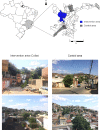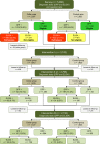Effectiveness of deltamethrin-impregnated dog collars on the incidence of canine infection by Leishmania infantum: A large scale intervention study in an endemic area in Brazil
- PMID: 30532255
- PMCID: PMC6287856
- DOI: 10.1371/journal.pone.0208613
Effectiveness of deltamethrin-impregnated dog collars on the incidence of canine infection by Leishmania infantum: A large scale intervention study in an endemic area in Brazil
Abstract
To reduce morbidity and mortality caused by visceral leishmaniasis (VL), the Brazilian Visceral Leishmaniasis Control and Surveillance Program promotes the diagnosis and treatment of cases, vector control, euthanasia of seropositive dogs, and health education. Nevertheless, the effectiveness of these measures is questionable as they lead to little reduction in the transmission of the disease. Thus, the effectiveness of strategies such as insecticide-impregnated collars, spot-on insecticides, and immunization of dogs should be assessed. Herein, we evaluated the effectiveness of deltamethrin-impregnated collars on reducing the incidence of Leishmania infantum infection in dogs living in an endemic area of VL. An intervention study was conducted and a total 5,850 dogs were analyzed in baseline. Of these 3,742 seronegative dogs were divided into two groups: collared and uncollared (control). Dogs were followed for 12 months and three interventions were performed. The Cox regression model was used to evaluate the effectiveness of the collar. All analyzes were performed by Intention-to-treat and per-protocol. By intention-to-treat, the incidence rates of L. infantum infection were 7.5 and 7.9 in the collar group, and 6.5 and 13.2 per 1,000 dogs-months in the control group after 6 and 12 months, respectively. In the per-protocol analysis, the incidence rates in the control group were similar to those observed in the intention-to-treat analysis. In the collar group, the incidence rate was 5.1/1,000 dogs-months after 6 and 12 months. The effectiveness by intention-to-treat after adjustment by the multivariate Cox model was 48%. In the analysis per-protocol, the effectiveness increased to 63%. Although collar use was effective when it was evaluated by intention-to-treat, higher effectiveness was found in the per-protocol analysis after one year of follow-up. The data emphasize the importance of the uninterrupted use of deltamethrin-impregnated collars to increase protection against canine VL.
Conflict of interest statement
The authors have declared that no competing interests exist.
Figures
References
-
- WHO. Leishmaniasis: situation and trends In: WHO, Global Health Observatory Data; [online database]. Geneva: World Health Organization; 2016 (http://www.who.int/gho/neglected_diseases/leishmaniasis/en/, accessed 18 July 2017). 2016.
-
- PAHO. Pan-American Health Organization (PAHO). Informe Epidemiológico das Américas Informe—Leishmanioses N° 5—Abril, 2017. Available from: http://iris.paho.org/xmlui/bitstream/handle/123456789/34113/informe_leis.... 2017.
-
- Molina R, Amela C, Nieto J, San-Andres M, Gonzalez F, Castillo JA, et al. Infectivity of dogs naturally infected with Leishmania infantum to colonized Phlebotomus perniciosus. Trans R Soc Trop Med Hyg. 1994;88(4):491–3. - PubMed
-
- Alvar J, Velez ID, Bern C, Herrero M, Desjeux P, Cano J, et al. Leishmaniasis worldwide and global estimates of its incidence. PLoS One. 2012;7(5):e35671 10.1371/journal.pone.0035671 PONE-D-11-24894 [pii]. - DOI - PMC - PubMed
-
- Ministério da Saúde. Manual de vigilância e controle da leishmaniose visceral, 1st ed Secretaria de Vigilância em Saúde, Brasília: Available:http://bvsms.saude.gov.br/bvs/publicacoes/manual_vigilancia_controle_lei... (Accessed in December 2016). 2006.
Publication types
MeSH terms
Substances
LinkOut - more resources
Full Text Sources



